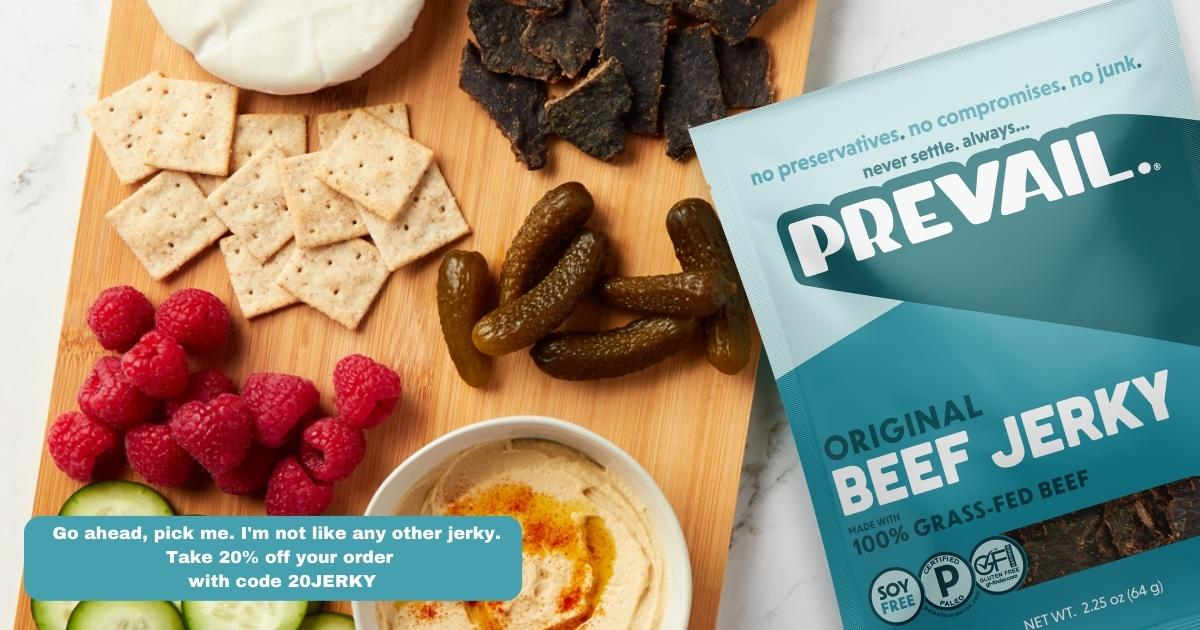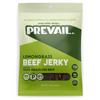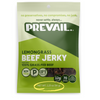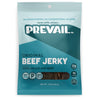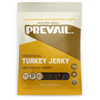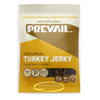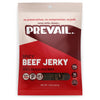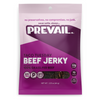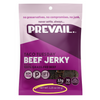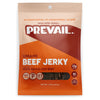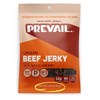Crafting the Perfect Charcuterie Board - Ideas and Tips to Create a Delicious Spread

Imagine hosting a gathering with friends, family, or coworkers, and you want to impress them with a stunning and delicious centerpiece that caters to everyone’s preferences. Enter the world of charcuterie boards, where the possibilities are endless, and customization is the name of the game! Ready to learn how to create the perfect charcuterie board with delectable cheeses, meats, fruits, and more? Let’s explore some charcuterie board ideas and embark on this flavorful journey together!
Short Summary
-
Create a delicious and stunning charcuterie board with unique themes, seasonal ingredients, decorative touches & accompaniments!
-
Pair cheeses & meats for the perfect balance of flavor & texture. Use creative layering techniques for an impressive presentation.
-
Enjoy your experience with wine pairings, utensils/serveware and portion sizes that satisfy everyone’s appetite!
Essential Components for a Charcuterie Board
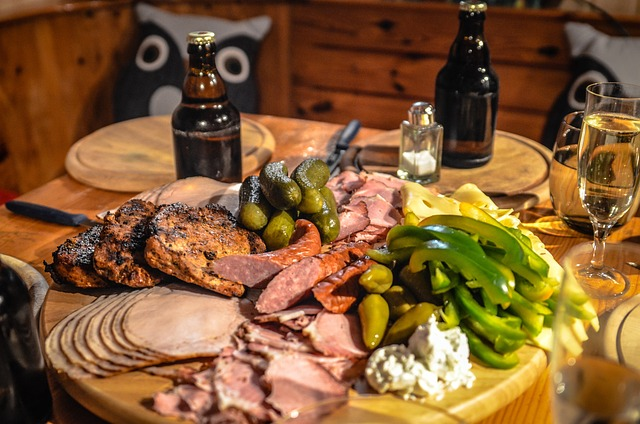
A charcuterie board is like a canvas, waiting for you to express your culinary creativity with a variety of ingredients. To create a gorgeous charcuterie board, you’ll want to include a mixture of:
-
Cheeses
-
Cured meats
-
Fresh fruit
-
Nuts
-
Crackers
This will provide different textures and flavors for your guests. Soft cheeses like goat cheese, blue cheese, and cream cheese can be combined with harder slice cheeses, such as cheddar or smoked gouda, to create a delightful contrast on your board.
When it comes to meat, opt for a combination of sliced meats like prosciutto, salami, and summer sausage. The addition of fresh fruits like berries, grapes, and halved pomegranates provides a burst of color and natural sweetness, while marcona almonds, candied nuts, and olives bring a satisfying crunch and a hint of saltiness to the board.
Don’t forget to include a variety of crackers, toasted baguettes, or seeded crackers for scooping and dipping! With these essential components, you’ll have all the ingredients you need to make a charcuterie board that’s not only visually stunning but also incredibly delicious.
Themed Charcuterie Boards
Why not take your charcuterie board to the next level by creating a themed masterpiece? Themed charcuterie boards are an exciting way to customize your spread, incorporating unique ingredients and flavors tailored to a specific theme or occasion. With the growing charcuterie board trend, it’s the perfect time to experiment and impress your guests.
In the following sections, we’ll explore seasonal boards, holiday boards, and dessert boards that will inspire you to create your own themed charcuterie masterpiece!
Seasonal Boards
One way to make your charcuterie board extra special is to embrace the flavors of the season. A seasonal charcuterie board highlights the freshest ingredients available during a particular time of year, creating a unique and mouthwatering spread. For example, a winter charcuterie board might include cured meats, cheeses, olives, roasted nuts, creamy spreads, crackers, veggies, and herbs, while a summer charcuterie board could showcase sliced salami, prosciutto, cheddar, goat cheese, brie, and summer fruits like fresh strawberries, grapes, and blackberries.
For a global twist, consider incorporating the following into your board:
-
Cheeses
-
Assorted nuts
-
Flavorful dips
-
Smoked salmon
-
Delectable artichoke hearts
The key is to choose ingredients that reflect the season and provide a diverse range of flavors, textures, and colors. With a little creativity, you can create a seasonal charcuterie board that is not only a feast for the eyes but also a delightful taste of the season.
Holiday Boards
Holiday gatherings are the perfect opportunity to showcase your charcuterie board skills with festive, themed spreads. Imagine a stunning fall-themed Thanksgiving charcuterie board filled with seasonal fruit, maple leaf cookies, and an adorable turkey-shaped arrangement of meats and cheeses. Or, for a New Year’s Eve charcuterie board, add a touch of elegance with a selection of premium cheeses, cured meats, smoked salmon, olives, and a glass of sparkling wine.
Easter charcuterie boards can be a delightful mix of pastel-colored candies, marshmallows, and a giant chocolate bunny, while Hanukkah boards can feature an array of sweets like Hanukkah cookies, blue berries, homemade gelt, and yogurt-covered pretzels. The possibilities are endless, and the key to creating a memorable holiday charcuterie board is to incorporate festive elements, seasonal ingredients, and a touch of creativity.
Your guests will be delighted by your holiday-themed year’s eve charcuterie board, making it the center of attention at any festive gathering.
Dessert and Sweet Boards

If you have a sweet tooth, you’ll fall in love with the concept of dessert and sweet charcuterie boards. These boards feature a scrumptious selection of chocolates, candies, and other dessert items, making them the perfect addition to any gathering or celebration. From chocolate truffles and yogurt-covered pretzels to fresh berries and bite-sized pastries, the options for a dessert charcuterie board are truly mouthwatering.
One delightful example of a dessert charcuterie board is an ice cream sundae board. Here’s how to create it:
-
Serve up a variety of ice cream flavors alongside waffle bowls, waffle cones, gluten-free sugar cones, and regular bowls.
-
Provide an array of toppings and sauces, such as chocolate sauce, caramel sauce, sprinkles, nuts, and whipped cream.
-
Encourage your guests to create their own custom ice cream sundae, using the different ice cream flavors and toppings.
-
Enjoy the interactive and indulgent experience of building and enjoying their own personalized ice cream sundaes.
Your dessert charcuterie board will be the star of the show, and your guests will love the delicious and customizable treat.
Pairing Cheeses and Meats
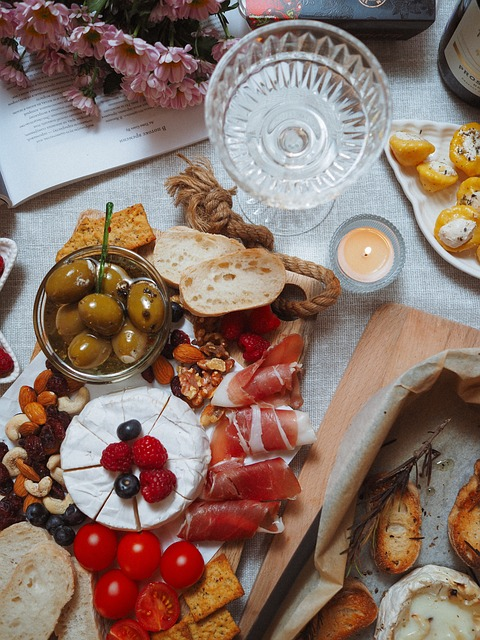
Creating a well-balanced and flavorful charcuterie board requires some knowledge of how to pair different types of cheeses and meats. A good rule of thumb is to combine a variety of hard cheeses with soft cheeses, offering a delightful contrast in terms of both taste and texture. For example, you might pair a creamy brie with a sharp cheddar or a pungent blue cheese with a milder gouda.
When it comes to meat, aim for a mixture of flavors and textures as well. You can’t go wrong with classic pairings like prosciutto and Parmesan, salami and Gouda, or chorizo and Manchego. Varying the colors and textures of the meats and cheeses on your board will not only create a visually appealing presentation, but also ensure that each bite offers a unique and delicious flavor combination.
Presentation Tips
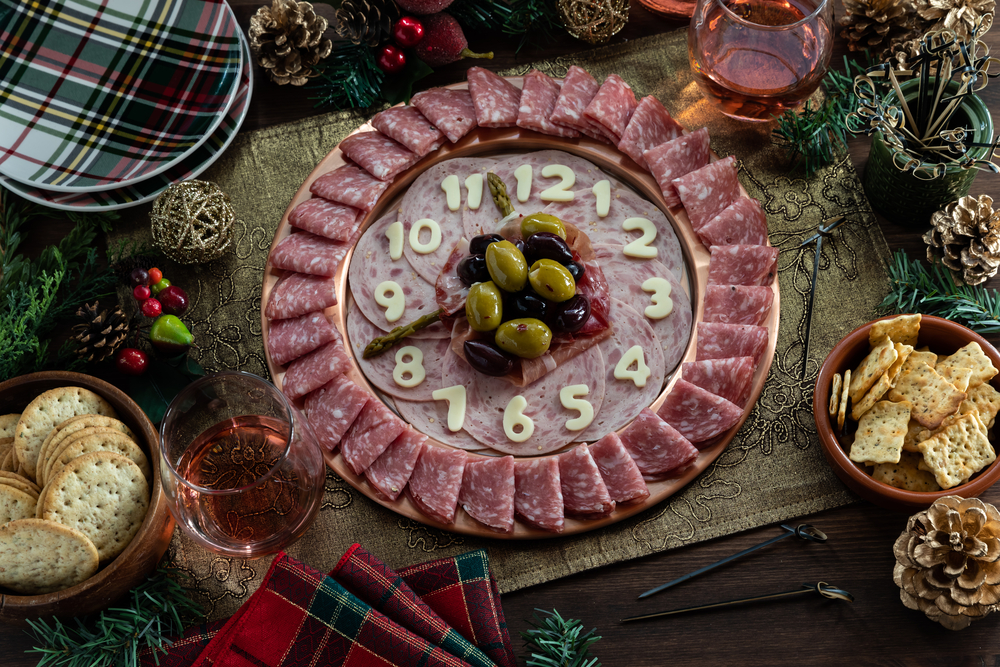
As we’ve mentioned before, a visually appealing cheese board, also known as a charcuterie board, is key to impressing your guests and creating a memorable dining experience.
In the following sections, we’ll dive deeper into platter choices, layering techniques, and decorative touches that will take your charcuterie board presentation to the next level!
Platter Choices
The foundation of your charcuterie board is the platter or board you choose to display your culinary masterpiece. There are a variety of options available, such as:
-
Cutting boards
-
Ceramic platters
-
Slate cheese boards
-
Marble slabs
Consider the size and shape of the board based on your personal preference and the number of guests you plan to serve. Smaller boards or platters work well for more intimate gatherings, while larger boards can accommodate a wider variety of ingredients for larger events.
When choosing the color of your dishes, white or clear dishes are recommended as they provide a clean and neutral backdrop, allowing the vibrant colors of your ingredients to shine. If you’d like to add a pop of color, consider incorporating colorful little bowls or dishes to hold your accompaniments and extras. Don’t be afraid to get creative with your platter choices and think outside the box by visiting antique shops or thrift stores to find unique serving dishes that will make your charcuterie board truly one-of-a-kind.
Layering Techniques
The way you arrange and layer ingredients on your charcuterie board can make a significant impact on its visual appeal. To create a stunning presentation, follow these steps:
-
Start by adding structure with little dishes.
-
Place the largest elements like cheeses and meats first.
-
Add smaller elements like nuts, fruits, and jams.
-
Use small dishes to separate different elements on the board.
-
This will help create a visually appealing presentation while also providing easy access to all of the delicious items on your board.
When it comes to arranging your meats, fold and roll them in visually appealing ways, such as making meat roses or salami triangles. This not only adds an artistic touch to your charcuterie board, but also makes it easier for your guests to pick up and enjoy each piece. With a little attention to detail and some creative layering techniques, you can transform your charcuterie board into a work of art that is both beautiful and delicious.
Decorative Touches
To elevate your charcuterie board even further, consider adding decorative touches like:
-
Fresh herbs
-
Garnishes
-
Fresh fruit
-
Nuts
-
Herbs like thyme or rosemary
These elements can be scattered throughout the board to add pops of color and natural beauty. You can also include small sides of sauces and jams in ramekins or serving bowls to add visual interest and give your guests more options for flavor combinations.
Don’t be afraid to get creative with your decorative touches! Consider using cookie cutters or other unique shapes to create interesting arrangements of meats and cheeses, or use garnishes like edible flowers to add an extra layer of sophistication to your charcuterie board. With a few thoughtful additions, you can transform your charcuterie board into a visually stunning masterpiece that will have your guests reaching for their cameras before they dive in.
Accompaniments and Extras
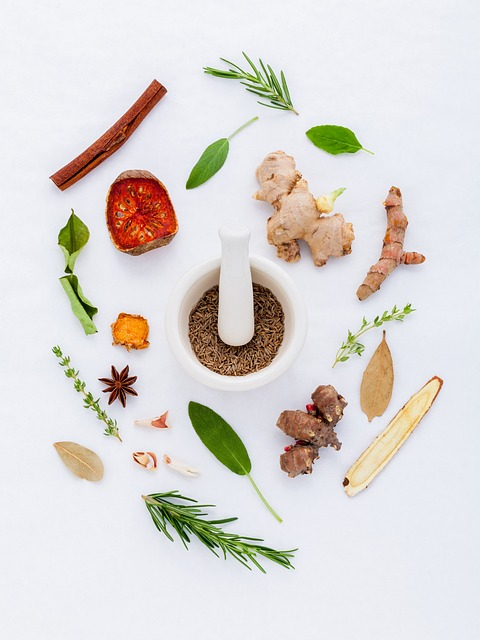
To enhance the flavor and presentation of your charcuterie board, consider adding a variety of accompaniments and extras. These items can include:
-
Jams
-
Pickles
-
Olives
-
Crackers or bread
-
Nuts
-
Fresh or dried fruits
-
Mustards or spreads
These elements complement the flavors of your meats and cheeses and provide additional textures and tastes for your guests to enjoy.
When selecting accompaniments and extras, think about the overall theme and flavors of your charcuterie board. For example, a Mediterranean-inspired board might include marinated artichoke hearts, sun-dried tomatoes, and a variety of olives, while a dessert charcuterie board could feature chocolate-covered strawberries, candied nuts, and caramel sauce for dipping.
By incorporating a diverse range of accompaniments and extras, you’ll ensure that your charcuterie board offers a delightful assortment of flavors and textures that will leave your guests craving more.
Customizing Your Board for Dietary Preferences
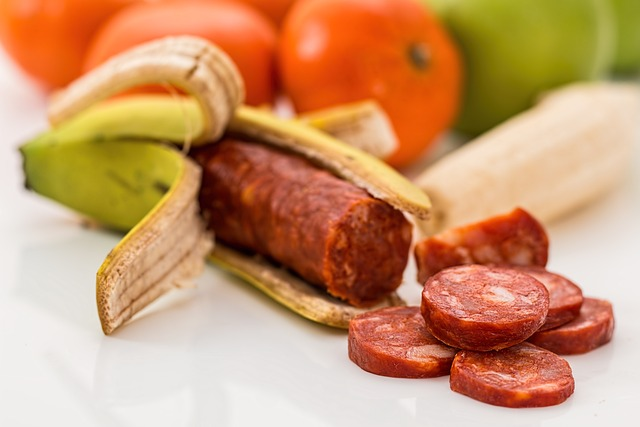
Creating a charcuterie board that caters to different dietary preferences is not only considerate, but also an opportunity to explore new and exciting ingredients. A vegan charcuterie board is a delicious and nutritious way to enjoy snacking. It typically consists of an assortment of vegan cheeses, falafel, pita triangles, hummus and other dips, nuts, fruits, and sliced vegetables. Gluten-free options can feature delicious gluten-free crackers, breads, cheeses, and meats, while nut-free options can include nut-free cheeses, crackers, breads, and meats.
By customizing your charcuterie board to accommodate various dietary preferences, you’ll ensure that everyone at your gathering can enjoy the delicious spread you’ve created. Plus, you might just discover some new and exciting ingredients that become staples in your future charcuterie board creations!
Tips for Serving and Enjoying Your Charcuterie Board

Now that you’ve learned how to create an amazing charcuterie board, it’s time to master the art of serving and enjoying it with your guests. In the following sections, we’ll explore wine pairings, utensils, and portion sizes to ensure that your charcuterie board experience is truly unforgettable.
Wine Pairings
A charcuterie board is the perfect excuse to indulge in a delightful wine pairing experience. The key to pairing wines with your charcuterie board is to consider the flavors and textures of your ingredients, along with the type of wine you’re serving. For instance, a dry white wine pairs wonderfully with a soft cheese, while a red wine complements a hard cheese.
Some of the best wines for charcuterie boards include:
-
Medium to full-bodied reds like Cabernet Sauvignon, Cabernet Franc, Merlot, Syrah, and Malbec
-
Crisp white wines like Pinot Grigio, Riesling, Prosecco, and Rosé
-
Lighter red wines like Barbera, Lambrusco, and Beaujolais
By choosing the right wine pairings, you’ll elevate the flavors of your charcuterie board ingredients and create a memorable tasting experience for you and your guests.
Utensils and Serveware
To ensure that your guests have a seamless and enjoyable charcuterie board experience, it’s important to provide the proper utensils and serveware. This includes:
-
Ramekins or serving bowls for dips or sauces
-
Spatulas and tongs for moving items around the board
-
Toothpicks for picking up small items
-
Cheese knives and slicers for cutting and serving cheese
-
Small wooden spoons for scooping out dips or sauces
When choosing your utensils and serveware, consider the materials and styles that will complement your charcuterie board’s theme and presentation. For example, you might opt for:
-
Ceramic or porcelain ramekins
-
Metal or plastic spatulas and tongs
-
Bamboo or plastic toothpicks
-
Stainless steel or plastic cheese knives
-
Bamboo or wooden spoons
By providing the appropriate utensils and serveware, your guests will be able to fully enjoy the delicious flavors and textures of your charcuterie board.
Portion Sizes
When creating your charcuterie board, it’s important to consider portion sizes based on the number of guests you plan to serve and the occasion. A good rule of thumb is to allow for roughly 3 ounces of meat and cheese per person if the charcuterie board is not intended to be an entire meal. This will ensure that your guests have enough variety to enjoy without feeling overwhelmed or running out of ingredients.
Keep in mind that portion sizes may vary depending on the preferences of your guests and the other dishes being served at your gathering. It’s always a good idea to have a little extra on hand just in case, as well as providing a variety of options for guests with different dietary preferences. By carefully estimating portion sizes, you’ll create a charcuterie board that satisfies everyone’s appetite while leaving room for other delicious dishes.
Summary
In conclusion, creating the perfect charcuterie board is an art form that combines delicious ingredients, creative presentation, and thoughtful consideration of your guests’ preferences. By exploring various themes, pairings, and decorative touches, you can craft a unique and memorable charcuterie board that will delight your guests and leave them craving more. So go ahead, unleash your inner culinary artist, and create the ultimate charcuterie board for your next gathering!
Frequently Asked Questions
What should be on a charcuterie platter?
Treat your guests to an epic charcuterie board filled with delicious cured meats, an array of cheeses, crunchy nuts and olives, fresh fruits and vegetables, flavorful dipping sauces, crackers, and other accompaniments.
Get creative and use colorful fresh herbs for a pop of color too!
What not to put on a charcuterie board?
When creating your charcuterie board, avoid adding peppers, tomatoes, asparagus, and jalapeno stuffed olives to keep it from being too spicy and overwhelming your taste buds.
How do I create a themed charcuterie board?
Get creative and make a themed charcuterie board with unique ingredients that reflect the desired theme! Have fun and incorporate seasonal, holiday, or dessert flavors for extra flavor.
What are some tips for pairing cheeses and meats on a charcuterie board?
Create a flavor-packed and balanced board by combining hard and soft cheeses with different meats. Try adding a variety of cured meats like salami, prosciutto, and chorizo. These meats will add a salty and savory flavor to the board.
How can I customize my charcuterie board for different dietary preferences?
Customize your charcuterie board by exploring vegan, gluten-free, or nut-free options and incorporating a variety of ingredients to please all tastes. Enjoy the process of creating an unforgettable experience!


